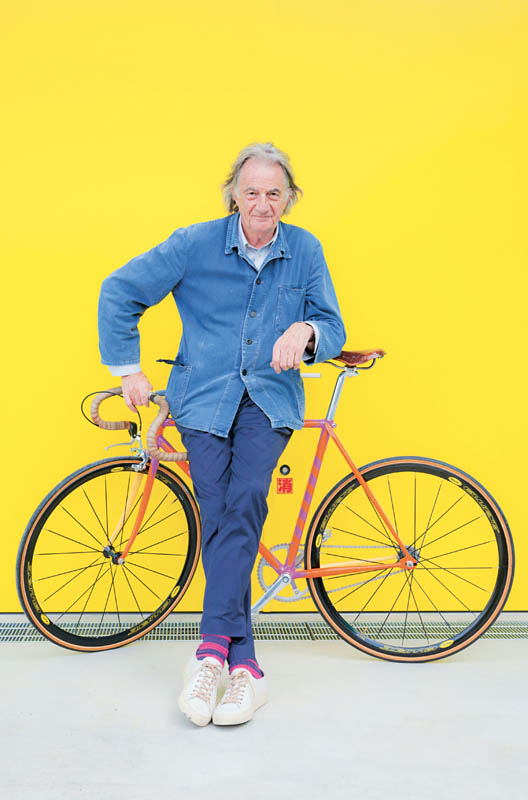Even if you only have a passing interest in fashion, the story of Paul Smith is a fascinating, and probably unrepeatable, one.
A self-trained designer who started out with a small shop in middle England—from where he effectively reconfigured the way in which men wear the suits—before transforming his business into a globetrotting, AED1 billion a year fashion empire.
What is even more remarkable—especially these days—is that the company now operates 166 stores globally and is still majority-owned by Smith himself. Simply put, at the age of 74, Sir Paul Smith has had a pretty extraordinary career.
This month his eponymous brand celebrates 50 years in business. Smith’s official celebrations took place in Paris earlier this year with a star-studded dinner and runway show that featured no shortage of his signature “classic with a twist” suits, and concluded with the designer scampering down the catwalk thanking his supporters—most of who were not yet born when the designer started making clothes.
In any industry—especially one as public-facing as fashion—a person doesn’t tend to oversee five decades of continued success without leaving a resounding legacy, and for Smith a lot of that legacy was making menswear fun. In the 1980s, along with Giorgio Armani, he led the trend to relax the lines of the suit. That developed through the ’90s where Smith’s self-taught approach to suit tailoring was expressive and quirky, without ever being needlessly showy. He is also widely credited with re-popularizing the boxer short.
Smith started making clothes in the mid-’70s. Just into his twenties he met his future wife, Pauline Denyer, who was a Royal College of Art fashion graduate and taught him sewing and pattern cutting in their flat in London. He supplemented these lessons with night-school classes from a man who happened to specialise in military tailoring and ceremonial dress. These two approaches fused Smith into an approach often called “classic with a twist”, though Smith has previously described it simply as: “no-bullsh*t clothing”.

Smith’s clothes have proved timeless and near-indestructible, better-made than makes any commercial sense. Smith seems to know intuitively that while most men don’t necessarily want others to comment on what they’re wearing, that doesn’t mean it should be boring. Or that it shouldn’t feature details that only they know about.
Smith has always had a pragmatic approach to design, and perhaps the most famous example of that is the famous Paul Smith stripe. As someone who was always wary of branding and recurring design trademarks, the continued success of the stripe season after season sat at odds with his ethos. Despite popular demand requesting it on clothing, accessories, boxer shorts, wallets and pretty much everything else, he would later made the decision to stop using the stripe on his designs as a way not to let it become the focal point of the brand, and overpower its central principles.
Smith opened his first store, the grand-sounding Paul Smith Vêtement Pour Homme, in 1970 in his hometown, when he was 23. It didn’t feature his own designs yet, but it already had some elements, in miniature, that would later become his trademarks. While most retailers aim for a fixed sales return per square foot, Smith’s boutiques have always been more focused on creating a “special feeling”. In its original incarnation, this meant offering records and magazines alongside the clothes. The ambition has since increased significantly. At his flagship store in London’s Mayfair, there’s a room with 26,000 dominoes covering the walls, built primarily to stimulate conversation between staff and customers.
The past year has been undoubtedly been a tough one for all in the industry, but it is certainly not the first major crisis that Smith has lived and worked through. The UK miners’ strike in the 1980s, two global recessions, and now an industry-halting pandemic—all challenges that takes a certain level of resilience to overcome. Smith has previously attributed that dogged survival instinct of his to his youth where, before turning his hand to tailoring, he had aspirations of becoming a professional cyclist until a major crash ended those hopes.
He has previously stated how pivotal the role of being part of a cycling team has played in his career when it came to fostering both a competitive spirit and a deeper understanding of teamwork. To this day, cycling and the symbolism of the bicycle is an important facet to both Smith and the Paul Smith brand.
For a man who is now in his eighth decade, Smith has shown that he is certainly not resistant to change. His collections have always been known for their almost-ADHD variety of ideas: perhaps 1,600 items in a season, produced in small runs, whereas other designers might typically design, say, 600, but in much bigger quantities.
The goal, he famously said, was that his customer should never go into a pub and see someone wearing the same shirt. And now, 50 years on, thanks to people like Paul Smith, we rarely do.
Esquire now has a newsletter – sign up to get it sent straight to your inbox.
Want up-to-the-minute entertainment news and features? Just hit ‘Like’ on our Esquire Facebook page and ‘Follow’ on our @esquiremiddleeast Instagram and Twitter account.


_3.jpg)

